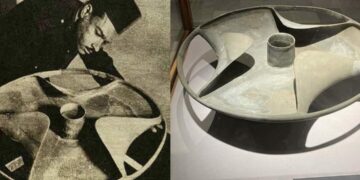Recent discoveries beneath the Great Pyramid of Giza have challenged long-held beliefs about this iconic structure. Using advanced technologies like LiDAR and ground-penetrating radar, researchers have uncovered a vast 2,000-foot-deep megalithic network of tunnels, shafts, and chambers beneath the pyramid. This intricate labyrinth, featuring spiral passages and large cubic rooms, suggests deliberate planning rather than natural formations. Traditionally viewed as a royal tomb for Pharaoh Khufu, the pyramid’s newly discovered underground features hint at a more complex purpose. Theories range from religious or ceremonial functions to speculative ideas, such as Christopher Dunn’s hypothesis that the pyramid served as a massive power plant harnessing Earth’s vibrations. While mainstream scholars remain cautious, the precise engineering of these structures raises questions about their true role, possibly tied to water management or spiritual practices. Safety concerns and government restrictions have limited exploration, but ongoing scans continue to reshape our understanding of ancient Egyptian ingenuity.
Theories on the Underground Chambers’ Purpose
The underground network beneath the Great Pyramid has sparked various theories. Some suggest these spaces were used for religious ceremonies, protecting sacred artifacts or aiding the pharaoh’s journey to the afterlife. Others propose a practical function, such as controlling groundwater to protect the pyramid’s foundation from the Nile’s floods. More speculative ideas point to the pyramid as a resonating chamber for generating energy, drawing comparisons to Nikola Tesla’s resonance experiments. Although these theories lack mainstream support, the precision of the tunnels and chambers suggests advanced engineering. Limited access and unstable conditions have hindered full exploration, but future technological advances may provide clearer answers.
Water Engineering at the Step Pyramid of Djoser
At Saqqara, the Step Pyramid of Djoser, designed by Imhotep around 2660–2640 BCE, marks Egypt’s first large-scale stone pyramid. Recent theories propose that the Egyptians may have used water-based systems to aid construction, moving beyond traditional ramps. Channels or basins, possibly linked to the nearby Gisr el-Mudir enclosure, could have harnessed Nile floodwaters to float heavy limestone blocks, reducing the workforce needed. Evidence of underground chambers and shafts supports the idea of water storage or manipulation. While ramps remain the dominant theory, the possibility of hydraulic innovation highlights the Old Kingdom’s architectural creativity, despite challenges from geological changes and desertification.
The Unfinished Pyramid at Zawyet el-Aryan
The site of Zawyet el-Aryan hosts an enigmatic unfinished pyramid from the Fourth Dynasty. Featuring a massive excavation pit, a deep central shaft, and an incomplete granite sarcophagus, the project was abandoned for unknown reasons—possibly due to a ruler’s sudden death, political instability, or structural issues in the bedrock. Speculated to belong to Pharaoh Baka or Bikheris, the site reflects typical Fourth Dynasty construction techniques but lacks a completed structure. The abandonment offers a glimpse into the challenges of pyramid-building, where foundation stability and resource allocation were critical.
The Great Pyramid of Cholula, Mexico
In Puebla, Mexico, the Great Pyramid of Cholula, also known as Tlachihualtepetl, surpasses the Great Pyramid of Giza in volume. Hidden beneath soil and vegetation, it was mistaken for a natural hill by Spanish colonizers, who built a church atop it in the 16th century. Constructed in phases from the 3rd century BCE, the pyramid features 8 kilometers of tunnels with murals and altars linked to the deity Quetzalcoatl. Built with adobe bricks and stucco, it served as a religious and pilgrimage center, showcasing Mesoamerican architectural and cultural sophistication.
The Pyramid of the Niches at El Tajín
In Veracruz, Mexico, the Pyramid of the Niches at El Tajín, built between 600–1100 CE, stands out for its 365 niches, likely symbolizing the solar year. Its design, creating dramatic light and shadow effects, suggests an astronomical or calendrical purpose, guiding agricultural and religious activities. El Tajín’s intricate carvings and urban planning reflect advanced knowledge of geometry and astronomy, marking it as a significant ceremonial and political center in Mesoamerica.
Animal Mummification at Giza
Along the Giza Plateau, archaeologists have uncovered caches of mummified animals, including crocodiles, cats, baboons, and ibises, linked to deities like Sobek, Bastet, and Thoth. These offerings, often placed in temples or catacombs, highlight the religious and economic significance of animal mummification in ancient Egypt. The careful embalming process underscores the integration of spirituality into daily life, revealing a deeper connection between Egyptians and their sacred animals.
The Collapsed Pyramid at Meidum
The Meidum Pyramid, possibly built for Pharaoh Huni or Sneferu, represents a transitional step in pyramid evolution, shifting from stepped to smooth-sided designs. Its collapse, leaving a tower-like core amid rubble, may have resulted from a steep angle or unstable foundation. The placement of its burial chamber above ground marks an architectural shift, influencing later designs. Meidum’s ruins, along with nearby mastabas featuring vivid reliefs, provide insight into Old Kingdom experimentation.
Edits in Egyptian Wall Paintings
Recent scans of ancient Egyptian wall paintings reveal that artists sometimes revised their work, adjusting gestures, symbols, or regalia to reflect changing religious or political priorities. Using non-invasive X-ray fluorescence, researchers have detected hidden layers, challenging the notion that Egyptian art was static. These findings highlight the dynamic interplay of art, religion, and power in ancient Egypt.
The Sphinx’s Missing Nose
The Great Sphinx of Giza’s missing nose has sparked myths, including a false claim that Napoleon’s soldiers destroyed it. Historical evidence suggests it was damaged in the 14th century by Muhammad Saim al-Dahar, possibly to deter local worship, combined with natural erosion from wind and sand. This iconic statue reflects the vulnerability of ancient monuments to both human actions and environmental wear.
Kom Ombo’s Twin Temple
The Kom Ombo Temple, located near Aswan, is unique for its symmetrical design dedicated to Sobek, the crocodile god, and Horus, the falcon god. Its mirrored layout, with dual sanctuaries and carvings of Roman emperors, reflects Egyptian beliefs in balance between chaos and order. Evidence of medical instruments and crocodile mummies suggests it also served as a healing center, blending worship with practical functions.
A Hidden Fetus in a Bishop’s Coffin
In Sweden, the naturally mummified remains of Bishop Peder Winstrup (d. 1679) revealed a surprising discovery: a fetus, likely a relative, hidden in his coffin. Likely placed there to secure a holy burial for an unbaptized infant, this find highlights 17th-century burial customs and the emotional complexities of navigating religious rules. The use of hops as a preservative underscores natural mummification techniques distinct from Egyptian methods.
Unas’ Pyramid at Saqqara
The pyramid of Pharaoh Unas at Saqqara, from the Fifth Dynasty (c. 2490 BCE), reflects the growing emphasis on solar worship. Though smaller and eroded, its unique mortuary temple placement and reliefs dedicated to Ra highlight theological shifts. The incomplete state and reused blocks suggest later modifications, illustrating the evolving nature of Old Kingdom burial practices.























